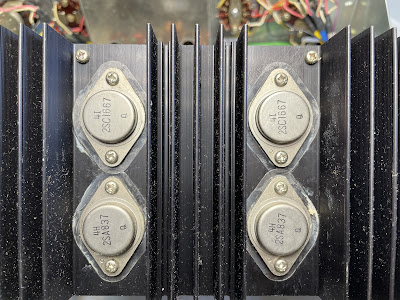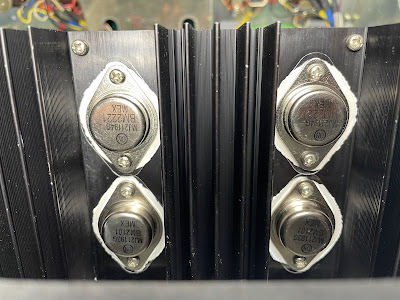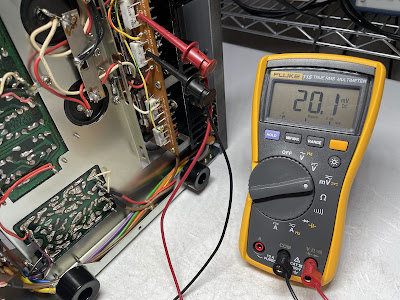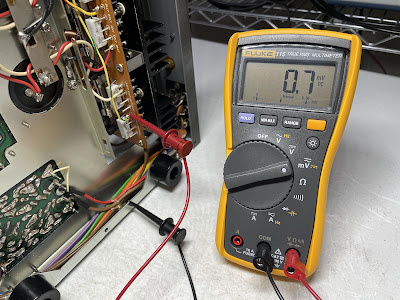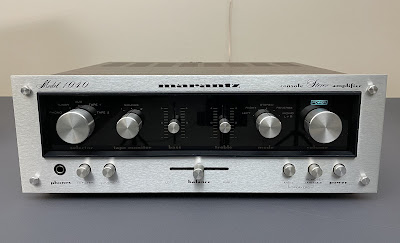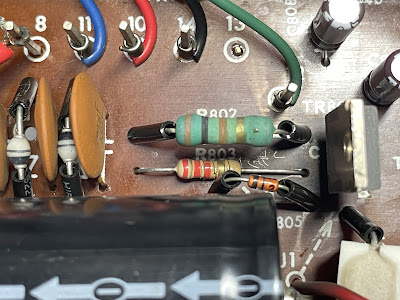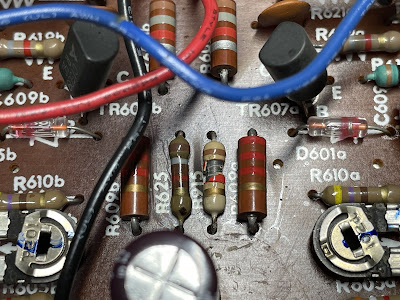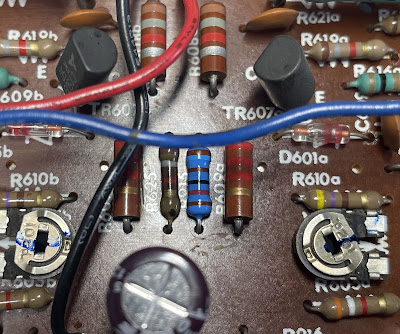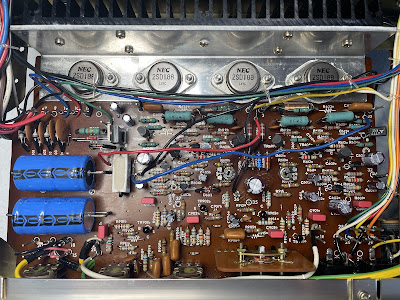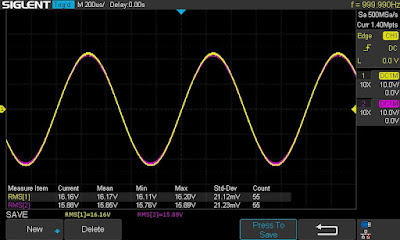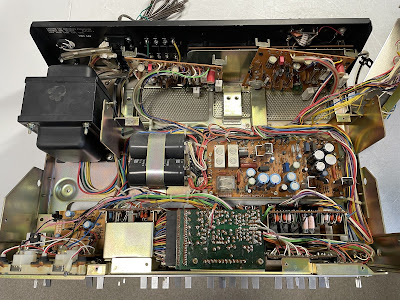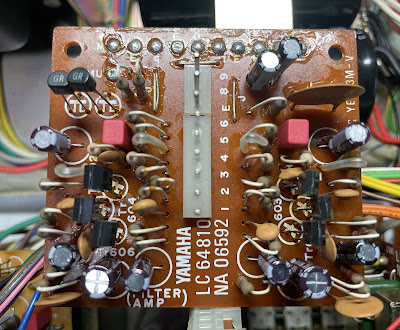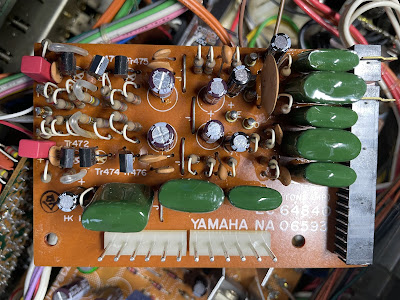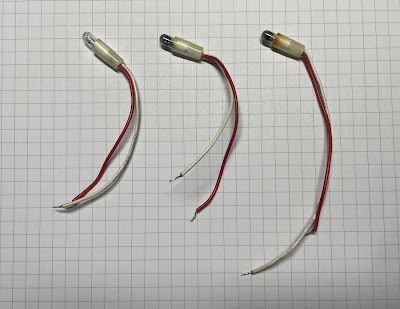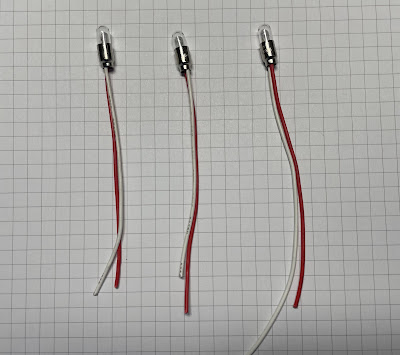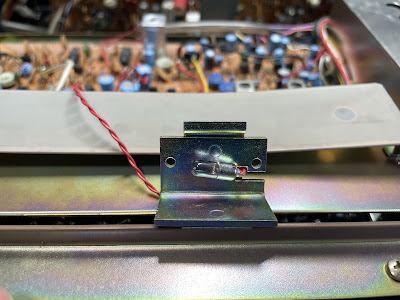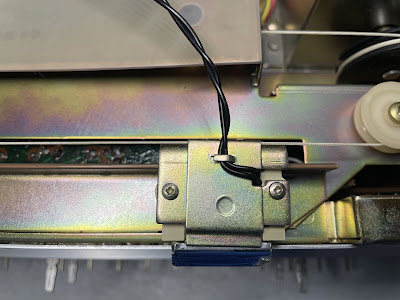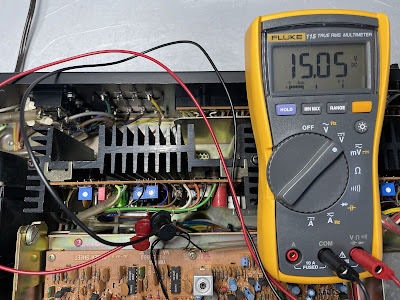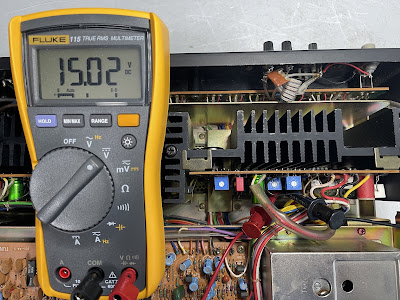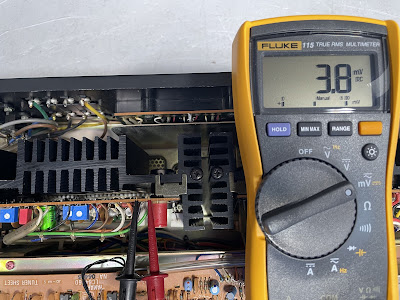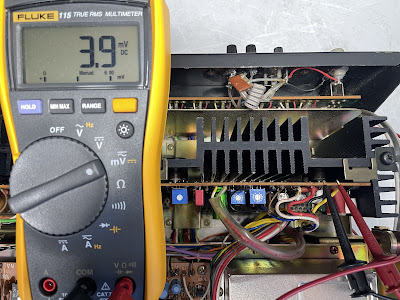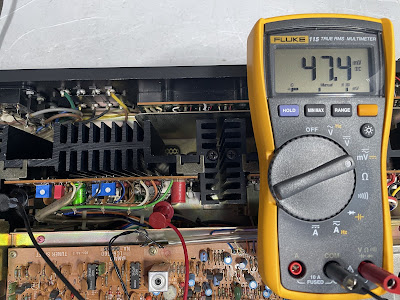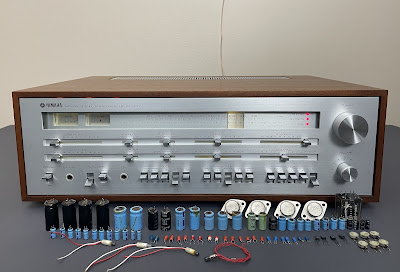Unit: Stereo Integrated Amplifier
Manufacturer: Marantz
Model: 1040
SN: 1634
Today I'm showcasing a Marantz 1040 stereo integrated amplifier that came in for restoration. This model was manufactured from 1974 to 1978. It produces 20 watts per channel into 8 ohms with no more than 0.3% total harmonic distortion. The optional walnut veneer cabinet for this model is WC-10. The retail price in 1975 was $199.95 (Ref. Marantz Dealer Price List).
Marantz 1040 is a service-friendly amplifier because of very good access to each PCB.
Power Supply Board (P800)
The power supply unit provides +35V DC (pin J807) to the phono amplifier and tone amplifier boards.
Four electrolytic capacitors (C803, C804, C805, and C806) installed on this board were replaced with low impedance and high-reliability Nichicon UPM e-caps. The dried glue under each capacitor was carefully removed. The original e-caps were tested with an Atlas ESR70 capacitance meter and the results are below.
Test results on original capacitors removed from the power supply board:
C803: rated capacitance – 330uF, measured – 335uF, ESR – 0.01Ω, deviation: +2%
C804: rated capacitance – 220uF, measured – 251uF, ESR – 0.02Ω, deviation: +14%
C805: rated capacitance – 100uF, measured – 122uF, ESR – 0.05Ω, deviation: +22%
C806: rated capacitance – 220uF, measured – 272uF, ESR – 0.01Ω, deviation: +24%
Power supply board - before and after
Tone Amplifier Board (PE01)
The tone amplifier board has six low leakage capacitors (CE03, CE04, CE07, CE08, CE09, CE10) installed in the signal path, two bi-polar e-caps (CE11, CE12), and three aluminum electrolytic capacitors (CE05, CE06, CE13). The original low leakage e-caps with a rated capacitance of 4.7uF were replaced with modern low leakage Nichicon UKL caps. The other two low leakage e-caps (CE07 and CE08) were replaced with high-quality film polyester WIMA caps. The original bi-polar caps (CE11 and CE12) were replaced with modern bi-polar Nichicon UES caps. And, the remaining aluminum e-caps were replaced with low impedance Nichicon UPW/UPM caps.
Test results on original capacitors removed from the tone amplifier board:
CE03: rated capacitance – 4.7uF, measured – 4.7uF, ESR – 1.39Ω, deviation: +0%
CE04: rated capacitance – 4.7uF, measured – 4.9uF, ESR – 1.26Ω, deviation: +4%
CE05: rated capacitance – 10uF, measured – 11uF, ESR – 0.57Ω, deviation: +10%
CE06: rated capacitance – 10uF, measured – 11uF, ESR – 0.61Ω, deviation: +10%
CE07: rated capacitance – 1uF, measured – 0.8uF, ESR – 3.4Ω, deviation: -20%
CE08: rated capacitance – 1uF, measured – 0.8uF, ESR – 3.6Ω, deviation: -20%
CE09: rated capacitance – 4.7uF, measured – 4.7uF, ESR – 1.31Ω, deviation: +0%
CE10: rated capacitance – 4.7uF, measured – 4.7uF, ESR – 1.54Ω, deviation: +0%
CE11: rated capacitance – 4.7uF, measured – 4.6uF, ESR – 1.39Ω, deviation: -2%
CE12: rated capacitance – 4.7uF, measured – 4.5uF, ESR – 1.4Ω, deviation: -4%
CE13: rated capacitance – 100uF, measured – 114uF, ESR – 0.05Ω, deviation: +14%
Tone amplifier board - before and after
Phono Amplifier Board (P400)
The phono amplifier board has four low leakage capacitors (C401, C402, C413, C414) installed in the signal path, and four aluminum electrolytic capacitors (C409, C410, C415, C416). The original low leakage e-caps (C401 and C402) with a rated capacitance of 4.7uF were replaced with modern low leakage Nichicon UKL caps. The other two low leakage e-caps (C413 and C414) were replaced with film polyester WIMA caps. The remaining aluminum e-caps were replaced with low impedance Nichicon UPW caps. Note that the capacitance deviation of the two original e-caps (C409 and C410) is almost 70% of the nominal value.
Test results on original capacitors removed from the phono amplifier board:
C401: rated capacitance – 4.7uF, measured – 4.5uF, ESR – 2.1Ω, deviation: -4%
C402: rated capacitance – 4.7uF, measured – 4.6uF, ESR – 1.5Ω, deviation: -2%
C409: rated capacitance – 100uF, measured – 167uF, ESR – 0.19Ω, deviation: +67%
C410: rated capacitance – 100uF, measured – 168uF, ESR –0.14 Ω, deviation: +68%
C413: rated capacitance – 1uF, measured – 0.8uF, ESR – 2.8Ω, deviation: -20%
C414: rated capacitance – 1uF, measured – 0.8uF, ESR – 2.6Ω, deviation: -20%
C415: rated capacitance – 100uF, measured – 118uF, ESR – 0.23Ω, deviation: +18%
C416: rated capacitance – 47uF, measured – 53uF, ESR – 0.26Ω, deviation: +13%
Phone amplifier board - before and after
Main Amplifier Board (P700)
The main amplifier board in Marantz 1040 is the most difficult board for servicing. This model does not have transistor sockets for power transistors. The leads of the four power transistors are directly soldered to wires. This design makes it difficult to disconnect the board from the heat sink since all transistors have to be de-soldered from the wires. This board can still be serviced with all wires connected, but in this case, the power transistors cannot be tested for current gain.
The main amplifier board has four low leakage e-caps (C701, C702, C705, C706) and five aluminum electrolytic capacitors (C709, C710, C711, C712, and C717). The original low leakage e-caps were replaced with modern low leakage Nichicon UKL caps. The remaining aluminum e-caps were replaced with low impedance Nichicon UPW caps. Note that the original e-cap C705 has only ~50% of the rated capacity.
Test results on original capacitors removed from the main amplifier board:
C701: rated capacitance – 3.3uF, measured – 3.1uF, ESR – 3.4Ω, deviation: -6%
C702: rated capacitance – 3.3uF, measured – 2.9uF, ESR – 3.9Ω, deviation: -12%
C705: rated capacitance – 47uF, measured – 25uF, ESR – 1.18Ω, deviation: -47%
C706: rated capacitance – 47uF, measured – 44uF, ESR – 0.14Ω, deviation: -6%
C709: rated capacitance – 100uF, measured – 121uF, ESR – 0.18Ω, deviation: +21%
C710: rated capacitance – 100uF, measured – 119uF, ESR – 0.34Ω, deviation: +19%
C711: rated capacitance – 47uF, measured – 52uF, ESR – 0.16Ω, deviation: +11%
C712: rated capacitance – 47uF, measured – 51uF, ESR – 0.64Ω, deviation: +9%
C717: rated capacitance – 10uF, measured – 11uF, ESR – 2.6Ω, deviation: +10%
The first stage of the main amplifier circuit is a differential pair amplifier consisting of two amplifying transistors with a common emitter: H701/H703 (left channel) and H702/H704 (right channel). The original PNP transistors installed in these positions are 2SA722. These transistors are not on my list of notorious transistors prone to failure. However, the owner of this amplifier complained about some distortion from the right channel and I decided to test the original 2SA722s to make sure they are well matched by current gain. So, I di-soldered all four transistors and tested them with Atlas DCA55 semiconductor analyzer. The pair of transistors from the left channel was very well matched (the current gain of H701 and H703 is 234 and 235, respectively). But the pair of original 2SA722s from the right channel had a mismatch of ~29% (the current gain of H702 and H704 is 273 and 353, respectively). Transistors installed in the differential pair amplifier are supposed to be gain matched as much as possible and a 29% mismatch is a lot for proper operation. So, I replaced the original 2SA722 transistors in both channels with new Fairchild KSA992 transistors. Before installation, each pair of KSA992 transistors was carefully matched by current gain and base-emitter voltage.
Test results on original 2SA722 transistors
H701 (left channel): hfe - 234, Vbe - 0.750V
H703 (left channel): hfe - 235, Vbe - 0.752V
H702 (right channel): hfe - 273, Vbe - 0.788V
H704 (right channel): hfe - 353, Vbe - 0.789V
Test results on new KSA992 transistors
H701 (left channel): hfe - 403, Vbe - 0.760V
H703 (left channel): hfe - 403, Vbe - 0.759V
H702 (right channel): hfe - 405, Vbe - 0.759V
H704 (right channel): hfe - 406, Vbe - 0.761V
Main amplifier board - before and after
Power Transistors
The original power transistors were removed, cleaned, and tested with an Atlas DCA55 semiconductor analyzer. The test showed that the left channel NPN transistor (H002, 2SC1667) has a shunt between the base and the emitter. I measured the resistance between the base and emitter and it was very low at ~8.3kΩ. The remaining three transistors passed the test.
NPN power transistor 2SC1667 from the left channel - shunt between the base and emitter
I don't have any new 2SC1667 transistors in stock and decided to replace all original power transistors with new ON Semiconductor transistors. Keep in mind that the NPN transistor 2SC1667 is a complement to the PNP transistor 2SA837. So, you can not install another NPN power transistor with similar parameters instead of 2SC1667. Well, you can but it is not the right thing to do. I replaced the original 2SC1667/2SA837 transistors in each channel with new MJ21194G/MJ21193G transistors. The new transistors are specifically designed for high-power audio output, have excellent gain linearity, and complement each other. The new Mica pads and fresh thermal compound were applied between each power transistor and heat sink. The fresh thermal compound was also applied to the thermal tracking diodes H005 and H006.
Original and new ON Semiconductor power transistors
DC offset and Bias Adjustments
The Bias is measured across two emitter resistors. The voltage drop across resistors R751 and R753 should be adjusted to ~20mV DC with the trimming resistor R763 (the DC voltmeter is connected between pins J709 and J711). This is a bias on the left channel. And on the right channel, the voltage drop across resistors R752 and R754 should be adjusted to ~20mV DC with the trimming resistor R764 (the DC voltmeter is connected between pins J720 and J721).
The DC offset is measured between pin J707 and ground on the left channel, and between pin J718 and ground on the right channel. It should be adjusted as close to zero volts as possible with the trimming resistors R761 and R762, respectively.
Bias on the left and right channels after restoration
DC offset on the left and right channels after restoration
Output Power Test
The final output power test was performed at the end of my restoration. The amplifier was loaded with a low inductance 8Ω/100W dummy resistor for each channel. The oscilloscope was connected across the speaker terminals and a sine-wave signal of 1kHz was applied to the AUX jacks. The output sine-wave signal was perfectly symmetrical on both channels with no clipping up to 13.48 VRMS (left channel) and 13.41 VRMS (right channel). It corresponds to the output power of 22.7W on the left channel and 22.5W on the right channel.
Output power test
As usual, all the knobs and the face plate were gently cleaned in warm water with dish soap. All controls have been cleaned with DeoxIT 5% contact cleaner and lubricated with DeoxIT FaderLube 5% spray.
The final result can be seen in the photos below. The amplifier looks like new again. The sound is excellent, with deep bass and clear highs. Please watch a short demo video at the end of this post. Thank you for reading.
Marantz 1040 - after restoration


_before%20servicing.jpg)
_after%20servicing.jpg)
_before%20servicing.jpg)
_after%20servicing.jpg)
_before%20servicing.jpg)
_after%20servicing.jpg)
_before%20servicing.jpg)
_after%20servicing.jpg)

